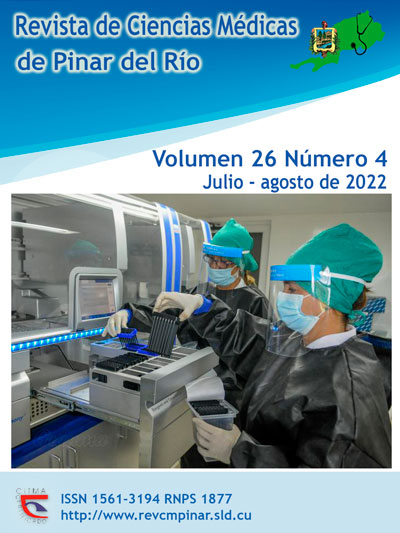Effectiveness of Tysuacril in aphthous stomatitis
Keywords:
STOMATITIS, APHTHOUS, TISSUE ADHESIVES, ENBUCRILATE, TREATMENT OUTCOME, COMPLEMENTARY THERAPIES.Abstract
Introduction: Tisuacryl is a biomaterial used in general and oral surgery, as well as in the treatment of aphthous stomatitis, considered a multifactorial process and currently the most common ulcerative disease of the oral cavity.
Objective: to determine the effectiveness of Tisuacryl with respect to conventional therapy in the treatment of aphthous stomatitis in Consolación del Sur, Pinar del Río, in the period from September 2018 to March 2020.
Methods: an analytical observational case-control study was conducted on 90 patients with aphthous stomatitis in Consolación del Sur, Pinar del Río, in the period from September 2018 to March 2020. Information was obtained from individual Periodontics medical records by obtaining oral and written consent from patients or their guardians. Results were obtained by statistical analysis including percent and Cochran Q nonparametric test.
Results: female sex and age group from 10 to 19 years old predominated for 46,7 % in the study group and 42,2 % in the control group; the decrease of pain and healing started in most patients 72 hours after treatment with Tisuacryl for 91,1 % and 55,6 % respectively; being five days after application of the drug all of them asymptomatic and almost all the oral aphthae healed.
Conclusions: aphthous lesions in the oral cavity evolved satisfactorily with the application of Tisuacryl being an effective treatment alternative in comparison with conventional therapy.
Downloads
References
1. Monteagudo Aguiar AR, Mora Díaz I, Jiménez Paneque RE, TamargoBarbeito TO, Hidalgo Costa T, Gutierrez Rojas ÁR. Uso de adhesivos tisulares para el cierre de heridas en la práctica médica. Rev Cubana Salud Pública [Internet]. 2016 Jun [citado 26/05/2021]; 42(2): 306-17. Disponible en: http://scielo.sld.cu/scielo.php?script=sci_arttext&pid=S0864-34662016000200013&lng=es
2. Pérez Hernández LY, Lorenzo Rodríguez M, Martínez Pita M, Rodríguez Ávila J, Labrador Falero DM. Efectividad del Tisuacryl como apósito periodontal en técnicas quirúrgicas. Rev Ciencias Médicas [Internet]. 2019 Abr [citado 26/05/2021]; 23(2): 250-8. Disponible en: http://scielo.sld.cu/scielo.php?script=sci_arttext&pid=S1561-31942019000200250&lng=es
3. Díaz Hernández MJ, Aragón Abreu JE, Díaz Martí DM, Mesa Gómez RA, Machado Ramos S, Morffi Pérez A. Tratamiento de heridas del complejo buco-facial con Tisuacryl®. MediCiego [Internet]. 2016 [citado 26/05/2021]; 22(2): [aprox. 5 p.]. Disponible en: http://www.revmediciego.sld.cu/index.php/mediciego/article/view/471
4. Serpa Romero X, Guarín Rodríguez P. Estomatitis aftosa recurrente: reporte de un caso. Duazary: Revista internacional de Ciencias de la Salud [Internet]. 2016 [citado 26/05/2021]; 13(2): 159-62. Disponible en: https://dialnet.unirioja.es/servlet/articulo?codigo=5608938
5. Acebo Choez AY. Manejo clínico y farmacológico en pacientes con estomatitis. [Tesis en Internet]. Ecuador: Universidad de Guayaquil. Facultad Piloto de Odontología. © 2021 [citado 26/05/2021]; [aprox. 104 p.]. Disponible en: http://repositorio.ug.edu.ec/bitstream/redug/51905/1/3556ACEBOallison.pdf
6. González Díaz ME, Toledo Pimentel B, Corrales Álvarez M, Veitia Cabarrocas F. Diagnóstico, pronóstico y tratamiento de la enfermedad periodontal inmunoinflamatoria crónica. Cap. 4. En: Colectivo de Autores. Compendio de Periodoncia. 2da ed. La Habana: Editorial Ciencias Médicas; 2017. p. 162-65.
7. Pardías Milán LC, Silveira Roblejo CN, González Domínguez M, Fernández Peña G, Llibre Almarales A. Eficacia y seguridad del TISUACRYL en el tratamiento de la estomatitis aftosa. MULTIMED [Internet]. 2017 [citado 26/05/2021]; 19(1): [aprox. 21 p.]. Disponible en: http://www.revmultimed.sld.cu/index.php/mtm/article/view/90
8. Córdoba MB. Aftas recurrentes en niños y adolescentes. Rev. Soc. Odontol. La Plata [Internet] 2018 [citado 26/05/2021]; 28(56): 19-22. Disponible en: https://scholar.google.com/scholar?hl=es&as_sdt=0%2C5&q=Aftas+recurrentes+en+ni%C3%B1os+y+adolescentes.+Rev.+Soc.+Odontol&btnG=
9. Grave de Peralta M, Páez González Y, Tamayo Ávila Y, Martínez Pérez M, Ochoa Pérez D. Diagnóstico y patogenia de la estomatitis aftosa recurrente. CCM [Internet]. 2019 [citado 26/05/2021]; 23(3): [aprox. 22 p.]. Disponible en: http://www.revcocmed.sld.cu/index.php/cocmed/article/view/3190
10. Leal Rodríguez MI, Leyva Céspedes N, Zamora Guevara N. Efectividad del oleozón en el tratamiento de la estomatitis aftosa recurrente. MediCiego [Internet]. 2019 [citado 26/05/2021]; 25(3):[aprox. 7 p.]. Disponible en: http://www.revmediciego.sld.cu/index.php/mediciego/article/view/1184
11. Rodríguez Archilla A, Raissouni T. Estudio clínico de 200 pacientes con estomatitis aftosa recurrente. Gac Med México. 2018 [citado 26/05/2021]; 154(2): 165-71. Disponible en: http://www.medigraphic.com/cgi-bin/new/resumen.cgi?IDARTICULO=79100
12. Díaz Couso Y, Arias Pérez Y, Garrido Labrada M, Reyes Nieblas J, Tamayo Ricardo CM. Ozonoterapia en pacientes mayores de 12 años con estomatitis aftosa recurrente. Rev. Electron. Zoilo [Internet]. 2018 [citado 26/05/2021]; 43(6): [aprox. 6 p.]. Disponible en: http://revzoilomarinello.sld.cu/index.php/zmv/article/view/1486
13. Pérez Álvarez MC, Márquez Argüelles DM, García Rogríguez L, Guerra Bretaña RM, Rodríguez Hernández JA, Nicolasa Rudi C. Evidencias clínicas empleando el biomaterial cubano Tisuacryl ® para tratar heridas de piel y mucosa oral. Rev Cubana Invest Bioméd [Internet]. 2017 Mar [citado 26/05/2021]; 36(1): 1-10. Disponible en: http://scielo.sld.cu/scielo.php?script=sci_arttext&pid=S0864-03002017000100004&lng=es
14. Vargas A, Foncea C, Campolo A. Adhesivos de cianoacrilato en cirugía oral y maxilofacial. Rev. Clin. Periodoncia Implantol. Rehabil. Oral [Internet]. 2017 Ago [citado 26/05/2021]; 10(2): 107-10. Disponible en: http://www.scielo.cl/scielo.php?script=sci_arttext&pid=S0719-01072017000200107&lng=es.
Downloads
Published
How to Cite
Issue
Section
License
Authors who have publications with this journal agree to the following terms: Authors will retain their copyrights and grant the journal the right of first publication of their work, which will be publication of their work, which will be simultaneously subject to the Creative Commons Attribution License (CC-BY-NC 4.0) that allows third parties to share the work as long as its author and first publication in this journal are indicated.
Authors may adopt other non-exclusive license agreements for distribution of the published version of the work (e.g.: deposit it in an institutional telematic archive or publish it in a volume). Likewise, and according to the recommendations of the Medical Sciences Editorial (ECIMED), authors must declare in each article their contribution according to the CRediT taxonomy (contributor roles). This taxonomy includes 14 roles, which can be used to represent the tasks typically performed by contributors in scientific academic production. It should be consulted in monograph) whenever initial publication in this journal is indicated. Authors are allowed and encouraged to disseminate their work through the Internet (e.g., in institutional telematic archives or on their web page) before and during the submission process, which may produce interesting exchanges and increase citations of the published work. (See The effect of open access). https://casrai.org/credit/



